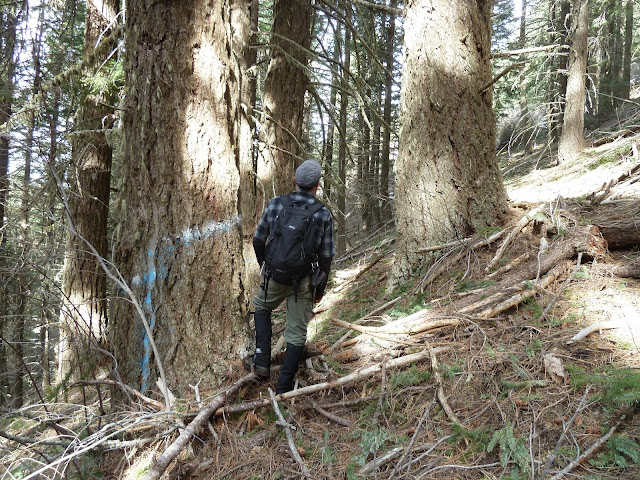The Bald Mountain area is a wild and beautiful region located at the headwaters of the Little Applegate River. The mountain supports a distinct variety of plant communities, including open and grassy balds, shrub fields, rock outcrops, old-growth forest, late seral forest and small sections of oak woodland. The mountain is also an important connectivity corridor, connecting the high elevation McDonald Peak Roadless Area near Wagner Butte with the Dakubetede Roadless Area at low elevations in the Little Applegate Valley. The old-growth forests in the Bald Mountain area allow late-seral species such as the Pacific fisher and northern spotted owl to disperse across the landscape from high to low elevations and from roadless wildland to roadless wildland.
 |
| Trees marked for removal on the proposed Jack-Ash Trail. |
The BLM is proposing to log old, complex forest on the south face of Bald Mountain in the Nedsbar Timber Sale, with trees marked for removal directly adjacent to the proposed Jack-Ash Trail. The proposed logging would heavily impact one of the most scenic portions of the trail, degrading the recreational experience of trail users for generations to come.
The Jack-Ash Trail is destined to become a thoroughfare for non-motorized recreationalists, yet the BLM has proposed heavy industrial logging in the trail's most spectacular old-growth forest on Bald Mountain. The extensive industrial logging proposed in the Nedsbar Timber Sale would impact the trail's forests and viewshed. The impact to the popular Sterling Ditch Trail would also be significant, marring large portions of the trail's viewshed with Nedsbar logging units.
 |
| Trees marked white would be logged in the Nedsbar Timber Sale. |
Forests in the area support the physical characteristics and stand structures that allow for exceptional fire resiliency. A closed canopy of massive, old trees rises above the forest floor, suppressing understory growth and inhibiting the development of dense understory fuel loads. Trees are relatively well spaced, support high canopies, and thick insulating bark. They are naturally fire resilient and should be maintained in that condition.
 |
| Complex and multi-layered northern spotted owl habitat on Bald Mountain proposed for logging in the Nedsbar Timber Sale unit 28-10A. |
Roughly half of the 65 acres proposed for logging on Bald Mountain's southern face is identified by the BLM as roosting and foraging habitat for the northern spotted owl. Much of the remainder is dispersal habitat. Two northern spotted owl nest sites are found nearby and the owls likely forage at least occasionally in the area. It is highly likely that the Pacific fisher is also found in the area and that both deer and elk utilize the forest as important thermal cover on cold winter nights. Black bear, cougar, bobcat, and countless other creatures call this place home and depend on its beautiful old forests for habitat.
 |
| A beautiful stand of large, old trees marked for logging on the south face of Bald Mountain in unit 28-10A. |
The units on Bald Mountain are likely some of the worst in the entire Nedsbar Timber Sale. Trees over 40" in diameter are marked for removal. In fact, in units 28-10A and 28-10B, the BLM has marked 316 trees over 24" in diameter for removal in the Nedsbar Timber Sale. Complex, old, fire-resistant stands would be helicopter logged to between 40%-60% canopy cover, leading to an increase in understory fuels. Many old snags would be removed as safety hazards in helicopter yarding operations. The old-growth characteristics of the stand would be heavily impacted, canopies seriously compromised and recreational opportunities degraded by proposed BLM logging treatments.
Units 28-10A, 28-10B, 28-10C, and 28-11B should not be logged. In fact, the units should be canceled from the Nedsbar Timber Sale. They are a remnant of complex, old forests that once covered nearly half the Little Applegate Watershed. With less than 15% remaining, it is time for the BLM to reform their timber program, stop logging old-growth trees and support rural communities by reducing fuels, providing recreational opportunities, contributing to the quality of life in rural areas, and learn to be good neighbors. Stop Nedsbar!
What can you do:
- Consider sending an email to the BLM and ask them to drop the controversial units across the Nedsbar Timber Sale, and particularly in the Bald Mountain area.
- Consider reading these blog posts and use what you have learned to write an official public comment this spring when the Environmental Assessment is released to the public.
- Consider making a donation to support the work of Klamath Forest Alliance in the Applegate Valley.
Krisit Mastrofini, Assistant Field Manager,
kmastrof@blm.gov
Diane Parry, Acting Field Manager
dparry@blm.gov
Dayne Barron, District Manager
d1barron@blm.gov
Jerome Perez, State Director
jperez@blm.gov
Below are maps and a photo essay of Nedsbar's Bald Mountain units.
 |
| A beautiful old grove marked for logging on Bald Mountain. |
 |
| A grouping of large old trees marked for removal in unit 28-10A. |
 |
| Large Doug fir marked in unit 28-11. In this unit the BLM marked trees yellow as "leave" trees, meaning these large fir marked blue would be removed. |
 | |
| More large trees marked for removal in the Bald Mountain Roadless Area. |










No comments:
Post a Comment